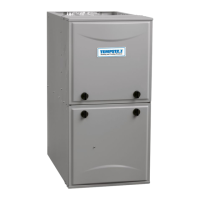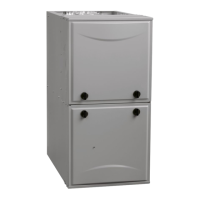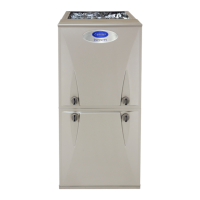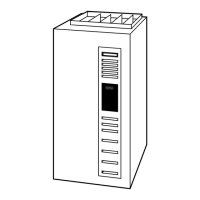F80CTL and G80CTL: Installation, Start–Up, Operating and Service and Maintenance Instructions
Manufacturer reserves the right to change, at any time, specifications and designs without notice and without obligations.
39
a. Leave 115-v power to furnace turned on.
b. Remove outer access door.
c. Look into blower access door sight glass for current LED status.
d. Remove blower access door.
NOTE: The Status Codes cannot be retrieved by disconnecting the limit
switch or draft safeguard switch. To retrieve Status Codes, follow the
procedure below.
2. Turn Setup Switch, SW1-1 “ON.”
3. Manually close blower access door switch.
4. Control will flash up to 7 Status Codes.
5. The last Status Code, or 8th Code, will be flashing heartbeat.
6. Turn SW1-1 “OFF.”
7. The Amber LED will flash heartbeat (bright-dim) continuously
which indicates proper operation.
8. Release blower access door switch, install blower access door and
replace outer door, or refer to the SERVICE label on the front of the
blower access door for more information.
Component Self-Test
Component Test can ONLY be initiated by performing the following:
1. Remove outer access door.
2. Remove blower access door.
3. Remove the wire from the “R” terminal of the control board.
4. Turn Setup Switch, SW-1-6 “ON.”
5. Manually close blower access door switch.
Blower access door switch opens 115-v power to control. No component
operation can occur unless switch is closed. Caution must be taken when
manually closing this switch for service purposes.
6. Component Test sequence will function as follows:
a. Inducer motor starts on high-speed and continues to run until
Step (d.) of component test sequence.
b. Hot surface igniter is energized for 15 sec, then de-energized.
c. Blower operates for 10 sec, then turns off.
d. Inducer motor goes to low-speed for 10 seconds, then turns off.
e. After component test is completed, one or more status codes
heartbeat, 2+5 will flash. See component test section of service
label for explanation of status codes.
NOTE: To repeat component test, turn setup switch SW1-6 OFF then
back ON.
f. Turn setup switch SW1-6 OFF.
7. RELEASE BLOWER ACCESS DOOR SWITCH, reattach wire to
“R” terminal on furnace control board, replace blower access door,
and replace outer access door.
CARE AND MAINTENANCE
For continuing high performance and to minimize possible furnace
failure, periodic maintenance must be performed on this furnace.
Consult your local dealer about proper frequency of maintenance and the
availability of a maintenance contract.
The minimum maintenance on this furnace is as follows:
1. Check and clean air filter each month or more frequently if
required. Replace if torn.
2. Check blower motor and wheel for cleanliness each heating and
cooling season. Clean as necessary.
3. Check electrical connections for tightness and controls for proper
operation each heating season. Service as necessary.
4. Inspect burner compartment before each heating season for rust,
corrosion, soot or excessive dust. If necessary, have furnace and
burner serviced by a qualified service agency.
5. Inspect the vent pipe/vent system before each heating season for
rust, corrosion, water leakage, sagging pipes or broken fittings.
Have vent pipes/vent system serviced by a qualified service agency.
WARNING
!
ELECTRICAL SHOCK HAZARD
Failure to follow this warning could result in personal injury, or death.
Blower access door switch opens 115-v power to furnace control. No
component operation can occur unless switch is closed. Exercise
caution to avoid electrical shock from exposed electrical components
when manually closing this switch for service purposes.
WARNING
!
FIRE OR EXPLOSION HAZARD
Failure to follow this warning could result in personal injury, death
and/or property damage.
Never store anything on, near, or in contact with the furnace, such as:
1. Spray or aerosol cans, rags, brooms, dust mops, vacuum cleaners,
or other cleaning tools.
2. Soap powders, bleaches, waxes or other cleaning compounds,
plastic or plastic containers, gasoline, kerosene, cigarette lighter
fluid, dry cleaning fluids, or other volatile fluids.
3. Paint thinners and other painting compounds, paper bags, or other
paper products. Exposure to these materials could lead to
corrosion of the heat exchangers.
WARNING
!
CARBON MONOXIDE POISONING AND FIRE
HAZARD
Failure to follow this warning could result in personal injury, death
and/or property damage.
Never operate furnace without a filter or with filter access door
removed.
WARNING
!
ELECTRICAL SHOCK AND FIRE HAZARD
Failure to follow this warning could result in personal injury, death,
and/or property damage.
Turn off the gas and electrical supplies to the furnace and install lockout
tag before performing any maintenance or service. Follow the operating
instructions on the label attached to the furnace.
CAUTION
!
CUT HAZARD
Failure to follow this caution may result in personal injury.
Sheet metal parts may have sharp edges or burrs. Use care and wear
appropriate protective clothing, safety glasses and gloves when
handling parts, and servicing furnaces.

